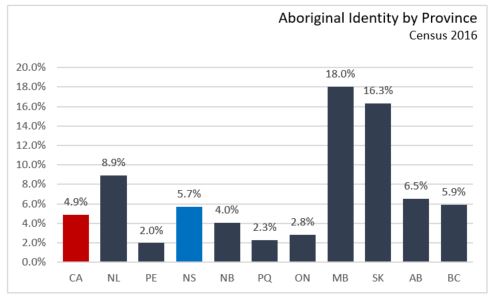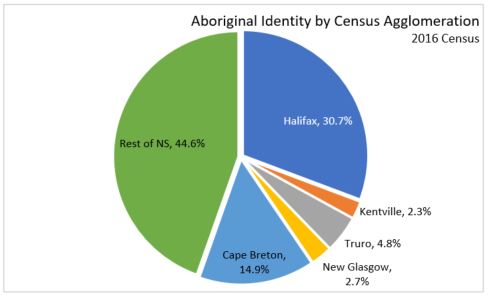The Economics and Statistics Division maintains archives of previous publications for accountability purposes, but makes no updates to keep these documents current with the latest data revisions from Statistics Canada. As a result, information in older documents may not be accurate. Please exercise caution when referring to older documents. For the latest information and historical data, please contact the individual listed to the right.
<--- Return to Archive
For additional information relating to this article, please contact:
October 25, 20172016 CENSUS: ABORIGINAL PEOPLES Today, Statistics Canada is releasing its first results on First Nations people, Métis and Inuit from the 2016 Census of Population.
In Nova Scotia, a total of 51,495 (5.7 per cent of NS population) Census respondents identified as Aboriginal, up 52.1 per cent from 33,845 in the 2011 National Household Survey. Of those who identified with only a single Aboriginal response, 51.7 per cent (25,830) identified as First Nations (North American Indian), 46.7 per cent (23,310) identified as Métis, and 1.6 per cent (790) identified as Inuk (Inuit) (Note that the category descriptions shown here are consistent across Canada). 835 respondents identified with multiple Aboriginal responses, and 720 identified with Aboriginal responses not included elsewhere.


Looking at age cohorts in Nova Scotia, most respondents of Aboriginal identity were in the 25-54 age cohort (2.2% of overall Nova Scotia population). Aboriginal idenfiers in the 0-14 age cohort accounted for 1.3 per cent of the population, followed by 15-24 year olds (0.9%), 55-64 year olds (0.7%),and 65 years and older (0.5%).
15,815 identified as Aboriginal in Halifax, 1,165 Aboriginal identifiers in Kentville, 2,460 in Truro, 1,415 in New Glasgow, and 7,675 in Cape Breton, and 22,965 in the rest of Nova Scotia.

Of special note is the growing number of people identifying as First Nations in the 2016 Census. In Atlantic Canada, the First Nations population more than doubled from 2006 to 2016. A significant part of this increase most likely stemmed from changes in self-reported identification, that is, people newly identifying as First Nations on the census.
In Nova Scotia, of the 51,495 people who identified as Aboriginal, 18,935 identified as "Registered or Treaty Indian", and 32,555 identified as "Not a Registered or Treaty Indian". On-reserve accounted for 48.7 per cent of Registered or Treaty Indians, and 51.3 per cent were Off reserve, while 99.6 per cent of those who identified as "Not a Registered or Treaty Indian" were off reserve.
For more information, see the Statistics Canada article, Aboriginal Peoples in Canada: Key Results from the 2016 Census.
<--- Return to Archive